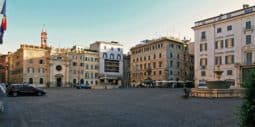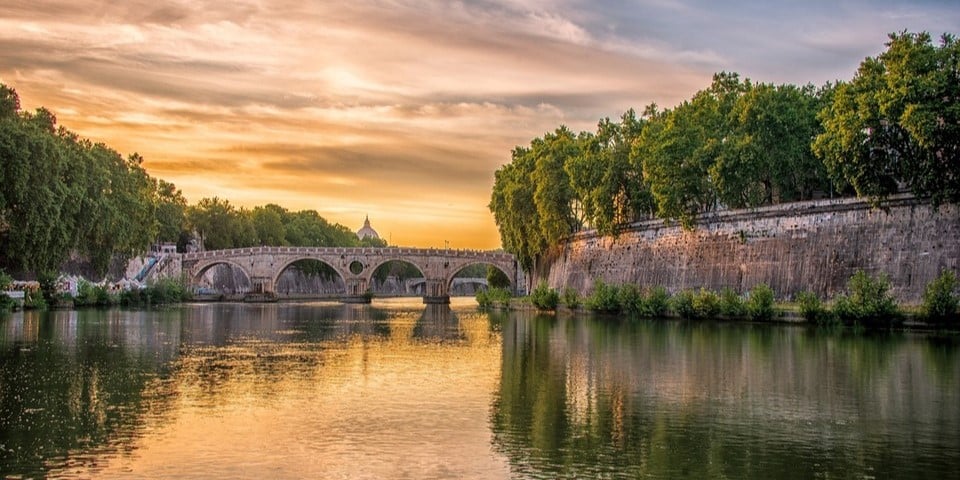
23512 views

Nowadays, there are 22 districts of Rome in total. However, since the period of the ancient Roman Empire, Rome has been divided by the authorities into different areas known as “regiones” (Latin) that have raised in number over time following the expansion of the city’s territory.
In 1921, a total of 22 different districts was defined.
Additional articles to help you understand the areas of Rome:
Each district has its features as an individual coat of arms.
Contents
Monti (mountains) comes from the three hills on which the district extends (Esquiline, Viminal, and Caelian). Its territory is large and houses many remains from the period of the Roman Empire as well as remains of the medieval city. The district stretches from the Colosseum to Via Nazionale. It is very picturesque and has a fantastic location. There are many wine bars and boutiques within walking distance of Rome’s most essential points of interest.
Trevi district has its name from the Latin trivium, which indicates the conjunction of three roads in the Piazzetta dei Crociferi, located nearby the Trevi Fountain.
What to see there? There are many famous palaces, such as Palazzo Odelaschi, Palazzo Colonna, Quirinal Palace, Palazzo Barberini, and Palazzo Antamoro. At the same time, there are many churches, such as Santa Maria in Trivio, church Maria in Trivio, the Church of St. Vincenzo and Anastasio, and Santi Apostoli church (which temporarily kept the tomb of Michelangelo).
Colonna district (column) has its name from the Column of Marcus Aurelius, located right in the center of Piazza Colonna. Moreover, a square adjacent to Piazza Colonna finds the Palazzo di Montecitorio, which is the seat of the Lower Chamber of the Italian Parliament. Its name derives from the Latin “Mons Acceptorius” or “Mons Citatorius,” an artificial barrier created by pre-Roman dwellers to reclaim what was previously a swamp and build dry huts on less wet soil. However, over the centuries, its original height flattened down, while the pavement leading to the Parliament’s building was still sloping.
Palazzo di Montecitorio was drawn by Gian Lorenzo Bernini around 1650, but the construction was completed half a century later.
Campo Marzio area has existed since the time of the ancient Roman Empire. However, not much remains of it can be found nowadays. The 4th Rione of Rome was the most populous in the Middle Ages. The north of the district is Flaminio (the ancient Roman Via Flaminia passed through the Porta del Popolo and ended at the Via del Corso).
Note: the house and studio of artist Antonio Canova is situated at the corner of Via Antonio Canova and the Via delle Colonette, while several of his works are located in the Borghese Gallery.
Another popular point of interest in the Campo Marzio district is the Spanish square with its 138 Spanish Steps. In addition, there is the 17th-century fountain, Fontana della Barcaccia, located in the middle of the square.
Ponte (bridge) has its name from the bridge Sant’Angelo, which originally belonged to this district before the absorption by the newborn Borgo district (decision of Pope Sixtus V). Interestingly, this area belonged to the Campus Martius (Campo Marzio) in ancient Roman times. The bridge started having compelling strategic importance when in 400 emperors Honorius turned Hadrian’s tomb into a stronghold so that the Aurelian wall (275) could be kept under guard.
Parione district includes famous Navona and Campo de’ Fiori squares. The district’s name comes from the fact that previously, there was a massive ancient wall in this area that probably belonged to the stadium of Domitianus. People gave the “Parietone” (“big wall” in ancient Italian) nickname to this wall. Moreover, during the ancient Roman Empire period, it belonged to the IX Augustan region called Circo Flaminio.
Regola district has its name from the Latin arenula, indicating the sand deposits created along the Tiber River since it runs along its entire length. There is a fusion of Renaissance architecture and contemporary buildings and restaurants. Moreover, the district is famous for leather and suede tanners who used deer skin to make clothes in the Middle Ages. This is the main reason why the symbol of the Regola became a deer.
Sant’Eustachio was the central part of Campus Martius in ancient times. However, nowadays, it is a separate district of Rome. During the Middle Ages, the area was rebuilt, so today, one can see many tiny private houses inhabited by the low and middle classes. The district’s coat of arms represents the head of a stag with a cross between its antlers, which is the symbol of Saint Eustace.
Pigna (pine) has its name because of the discovery of a gigantic pine cone located in medieval times near the Baths of Agrippa. The giant pine cone once decorated a fountain in ancient Rome next to the Temple of Isis.
The Pigna was moved first to the Old Basilica of Saint Peter, where Dante saw it and employed it in the “Divina Commedia” as a similarity to the giant proportions of the face of Nimrod. Then, in the 15th century, it was moved to the upper end of Bramante’s Cortile del Belvedere, which is nowadays usually called the “Cortile della Pigna,” linking the Vatican and the Palazzo del Belvedere.
Read more about the Umbrella Pine Trees in Rome.
Campitelli is considered the most tourist district, while it is the least populated. The reason is simple: there are many famous Roman points of interest as the Capitol and the Roman Forum. Here’s the list of churches located in the Campitelli:
Sant’Angelo district is home to the Jewish Ghetto and is the smallest district of Rome. It has its name from the Church Sant’Angelo in Pescheria. During the Middle Ages, because of the Tiber Island‘s bridges, Sant’Angelo was the only passage inside the Aurelian Walls. Therefore, many small artisan shops and baronial houses began to appear. However, there was a long reconstruction process in the early 20th century.
Ripa district has its name after the former river harbor, the Ripa Grande. Nowadays, the area contains many important tourist attractions. The district’s territory used to be bigger, but in 1921, it was divided, and Testaccio en San Saba got their quarters. Some famous tourist attractions of the Ripa rione are the Mouth of Truth (Bocca della Verita), the Circus Maximus, and the Roseto Comunale (Rose Garden).
Trastevere district is located on the other side of the Tiber River. It is one of the most popular areas of Rome because of its bars and restaurants. If you want to feel the authentic Italian atmosphere, you should go to Trastevere since there are many old buildings, tiny streets, and small local shops.
Read about the best restaurants in the Trastevere district.
Borgo (burg) has been home to Pope Benedict XVI, Raphael, Michelangelo Buonarotti, and many other famous persons. The district is located between Prati, Trastevere, the Tevere, Castel Sant’Angelo and Vatican City. Its coat of arms represents a lion (after the name “Leonine City,” also given to the district) lying in front of three mounts and a star.
Esquilino district houses the largest of Rome’s seven hills. Moreover, it was one of the imperial neighborhoods in ancient Roman times. After the unification of Italy in 1870, this district became the home of wealthier classes who copied the architectural style of Torino’s royal class and built many spacious public squares ringed with porticoes.
However, nowadays, Esquilino is one of the most multicultural areas of Rome and is the best place to try international foods. Also, you can visit its farmer’s market.
Ludovisi district hosted numerous noble villas in the Renaissance, including Villa Ludovisi. Nowadays, its main point of interest is Via Veneto, one of Rome’s most beautiful and wealthiest streets. Via Veneto is especially popular because of Fellini’s film La Dolce Vita. However, the more significant part of the rione was reconstructed after the unification of Italy. The Church of Santa Maria della Conciliazione is the recommended attraction, where you will see five chapels decorated with bones and skeletons of dead Capuchin monks.
Sallustiano district has its name for the Gardens of Sallust (Horti Sallustiani). These are former gardens that had been commissioned by Gaio Sallustio Crispo, a historian and senator of the Roman Republic. Moreover, the rione is located on the northern part of Quirinal Hill. Unfortunately, Sallustio’s villa was destroyed by the Visigoths in the early 5th century. Also, Algeric warriors destroyed the aqueducts that fed the area and made inhabitants move to other areas.
Sallustiano came back to life when Pope Sixtus V had one of the aqueducts repaired.
Castro Pretorio is located north of the main railway station Roma Termini. Also, the main points of interest are the Church Santa Maria degli Angeli and two seats of the Museo Nazionale Romano. When Rome was first divided into rioni, the Castro Pretorio did not exist yet. Its current name is derived from the ruins of the Castrum Praetorium, during Emperor Tiberius’ reign, the barrack of the Praetorian Guard.
Celio is a well-known area of the famous Colosseum, and the Arch of Constantine is located in this district. The rione is named after the hill Celio, one of Rome’s seven original hills.
Until 1921, when Rome’s borders were re-divided, this district belonged to the rione Monti and in part to Campitelli. The coat of arms of the area is the profile of an African warrior with a head covering in the shape of the head of an elephant. It became a symbol of the rione because the empire’s African legionnaires used to live on the Colle Celio.
Testaccio district has its name, the Mount Testaceous, an accumulation of debris created by the port Ripa Grande in ancient times. Nowadays the rione is one of the most visited tourist areas since there are many nightclubs and bars. At the same time, Testaccio is a working-class neighborhood with many local flairs. There you will find many osteries and pizzerias with fantastic local Roman dishes and one of Rome’s most prominent farmers’ markets.
San Saba district is also called Piccolo Aventino (small Aventine). It has its name from the main Church in the rione, with its adjacent convent dating back to the 8th century AD. At the beginning of the 20th century, part of San Saba was designated as a zone of houses for the middle class.
Prati district is famous for its wide streets, elegant buildings, and modern European atmosphere. It is one of the most current and distinctive areas of Rome. Moreover, there you will find many bars and restaurants, and this rione is a good choice for shopping.
This website uses cookies. For more info read the cookies policy
Rome.us © 2025. Created with love by Roman experts and guides.